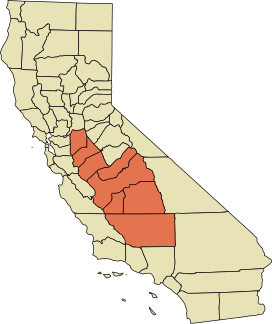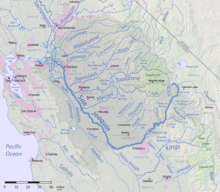
Back وادي سان هواكين Arabic San Joaquin Valley Czech San Joaquin Valley German Valo San Joaquin Esperanto Valle de San Joaquín Spanish San Joaquin harana Basque دره سنخواکین Persian San Joaquin Valley Finnish Vallée de San Joaquin French Valle di San Joaquin Italian
| San Joaquin Valley | |
|---|---|
| Valle de San Joaquín (Spanish) | |
 San Joaquin Valley | |
 A map of the counties encompassing the San Joaquin Valley ecoregion | |
| Geography | |
| Location | California, United States |
| Population centers | Stockton, Tulare, Porterville, Modesto, Turlock, Merced, Fresno, Visalia, Bakersfield, Clovis, Hanford, Madera, Tracy, Lodi, Galt, Manteca and Ceres. |
| Borders on | Sierra Nevada (east), Sacramento–San Joaquin River Delta (north), Coast Range, San Francisco Bay (west), Tehachapi Mountains (south) |
| Coordinates | 36°37′44″N 120°11′06″W / 36.62889°N 120.18500°W |
| Traversed by | Interstate 5, State Route 99 |
| Rivers | San Joaquin River |

The San Joaquin Valley (/ˌsæn hwɑːˈkiːn/ SAN whah-KEEN; Spanish: Valle de San Joaquín) is the southern half of California's Central Valley. Famed as a major breadbasket,[1] the San Joaquin Valley is an important source of food, producing a significant part of California's agricultural output.
San Joaquin Valley draws from eight counties of Northern and one of Southern California, including all of San Joaquin and Kings counties, most of Stanislaus, Merced, and Fresno counties, and parts of Madera and Tulare counties, along with a majority of Kern County in Southern California.[2] Although the valley is predominantly rural, it has three densely populated urban centers: Stockton/Modesto, Fresno/Visalia, and Bakersfield.[3]
- ^ Righter, Robert W. (2005). The Battle over Hetch Hetchy: America's Most Controversial Dam and the Birth of Modern Environmentalism. Oxford University Press. p. 149. ISBN 9780199882069.
- ^ "San Joaquin Valley Fact Sheet". Valley Clean Air Now. Archived from the original on October 22, 2014. Retrieved October 18, 2014.
Eight counties comprise the San Joaquin Valley, including all of Kings County, most of Fresno, Kern, Merced, and Stanislaus counties, and portions of Madera, San Luis Obispo, Tulare counties
- ^ Carle, David (2006). Introduction to Air in California. University of California Press. p. 95. ISBN 9780520247482.